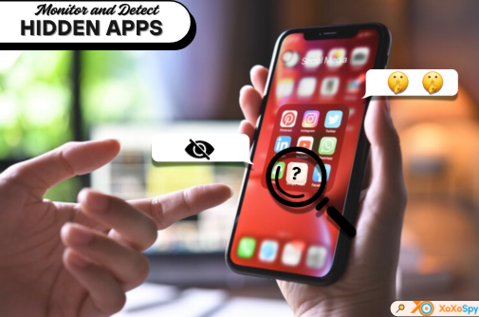In today’s digital age, parenting doesn’t stop at the dinner table or the front door it extends to your child’s smartphone. As of 2025, more parents are stepping into the world of digital parenting, learning how to supervise and guide their children’s online behavior. One of the growing concerns among parents is the rise of hidden apps on Android apps designed to conceal messages, images, or even other apps.
Whether it’s a disguised calculator that hides private chats or an app that bypasses parental restrictions, these tools are easily accessible and dangerous in the wrong hands. This article will help you understand why kids use hidden apps, how to detect hidden apps, and which tools and strategies can help you monitor your child’s digital activity responsibly.
In today’s digital world, responsible parenting includes online safety. Learn how to monitor your child’s device, detect hidden apps on Android, and protect them using a reliable spy phone app.
Why Kids Use Hidden Apps
Children and teens are often more tech-savvy than their parents, and they know how to install and use hidden apps without getting caught. But why do they do it?
- Peer pressure and trends: Some apps are used because “everyone is doing it.”
- Curiosity or rebellion: Teens love pushing boundaries, and hiding apps is one way to do that.
- Privacy concerns: Some kids may feel their privacy is being invaded and try to hide what they consider personal.
- Avoiding rules: Kids may install hidden apps to access content they know they’re not allowed to use, like explicit media or unsafe chat platforms.
Understanding why is the first step toward handling the what.
Common Types of Hidden Apps
Not all Android spy app look suspicious at first glance. Some are specifically designed to fool even the most attentive parents.
- Vault apps: These appear like calculator or calendar apps but hide private files or conversations behind a password.
- Hidden messaging apps: Apps like “GoSMS” or “CoverMe” provide secret texting features.
- Spy or tracking apps: Installed without permission, these can monitor or track a child without their knowledge.
- Apps that bypass restrictions: These help teens avoid parental controls or install unapproved content.
Recognizing these types of apps can help you protect your child more effectively.

How to Manually Detect Hidden Apps on Android
You don’t always need advanced software to detect hidden apps. Start with basic checks:
- App Drawer & Settings: Go to Settings > Apps and look for apps with odd names or blank icons.
- Recent Activity: Check the Play Store and phone history to see what was installed recently.
- Safe Mode: Booting the phone into safe mode disables third-party apps, making it easier to spot what shouldn’t be there.
- Data & Battery Usage: Some hidden apps consume a lot of data and battery review usage stats regularly.
- Permissions: An app asking for camera, microphone, or location access without reason is a red flag.
These simple steps can help you uncover suspicious apps before they do any harm.
Best Parental Monitoring Tools to Detect Hidden Apps
If manual detection isn’t enough, try using trusted parental control apps or an Android spy app. Here are some reliable options:
- XOXOSpy: Great for detecting unusual activity across apps and social media.
- Qustodio: Offers a user-friendly dashboard to track app usage and block inappropriate content.
- mSpy: A powerful Android spy app that gives detailed reports of hidden or deleted apps.
Key features to look for:
- Alerts for new app installs
- Real-time activity tracking
- App-blocking functionality
- Access to hidden app logs
These tools are designed to help, not invade. Used responsibly, they can strengthen your child’s safety.
Setting Digital Boundaries with Kids
Monitoring is important, but trust matters too. Here’s how to balance both:
- Open communication: Talk regularly about internet safety and why you’re checking their phone.
- Set app rules: Make it clear which types of apps are allowed and which aren’t.
- Explain consequences: Help them understand the risks of inappropriate or secretive online behavior.
- Keep learning: Technology evolves, and so should your parenting strategies.
The goal is to guide, not to spy.

When to Take Action
If you suspect something’s wrong, don’t ignore the signs. These may include:
- Increased secrecy or defensiveness
- Sudden changes in phone behavior (e.g., turning off screen quickly)
- Apps that disappear and reappear
Approach your child calmly. Explain what you’ve found and why it concerns you. In some cases, it may be necessary to remove apps, reset the phone, or even seek help from a professional if safety is at risk.
Conclusion
Hidden Apps on Android can be tricky to spot, but with the right knowledge, tools, and open communication, you can stay one step ahead. As a digital parent, your job is to protect, not invade. Use monitoring tools wisely, maintain trust, and always stay informed about the latest trends in app safety.
Your involvement today can protect your child’s digital future tomorrow.

Frequently Asked Questions
Q1. How can I tell if my child has hidden apps on their Android phone?
Check the app list in settings, look for duplicate or odd-named apps, review recent downloads, and use a monitoring tool like XOXOSpy or mSpy.
Q2. Are hidden apps illegal?
Not always. Many are legal but can be misused. However, if used for stalking or spying without consent, they can be illegal depending on your location.
Q3. Can I use an Android tracker app without rooting the phone?
Yes, many tracker and monitoring apps now work without rooting, offering features like app monitoring, web filtering, and hidden app detection.

